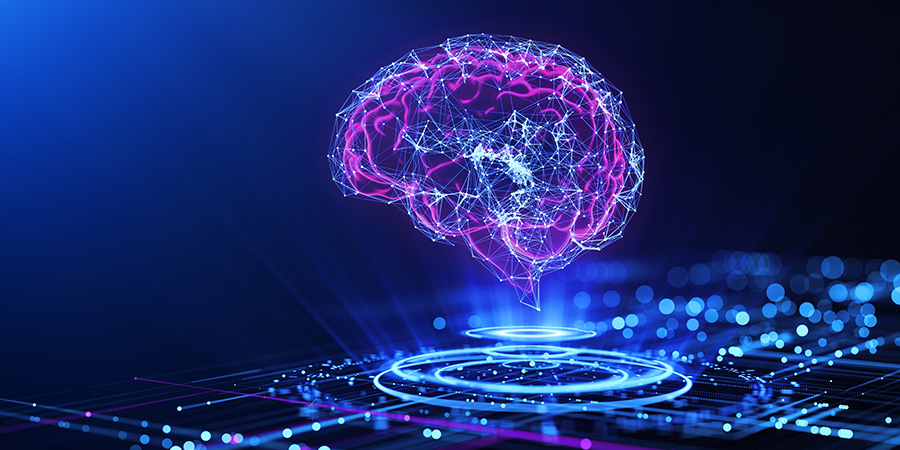As artificial intelligence (AI) evolves, it is no surprise that it is drawing inspiration from one of the most sophisticated systems in existence: the human brain. Recent advances in brain-inspired networks are pushing the boundaries of how we think about computing and communication, and they could hold the key to more efficient, scalable, and adaptive systems. These networks mimic the way biological brains process information, enabling the development of machines that can learn, adapt, and perform complex tasks more effectively than traditional models.
At the core of brain-inspired networks is the concept of spiking neural networks (SNNs). Unlike traditional neural networks, which rely on continuous signals, SNNs use discrete, time-dependent spikes to transmit information, similar to how neurons in the brain communicate through electrical impulses. This method of communication is both energy-efficient and fast, making it an ideal model for developing low-power, high-speed computing systems. As explained in a recent study published in Nature Communications, SNNs operate by encoding information in the timing and frequency of spikes, which allows them to perform complex computations with a minimal energy footprint.
Additionally, researchers are exploring how to integrate synaptic plasticity—the brain's ability to strengthen or weaken synapses based on experience—into artificial networks. This concept is vital for creating systems that can adapt and improve over time.
Also Read: Linking Human Brains to Computers
Brain-Inspired Design for Sustainable AI
The environmental impact of AI is becoming a growing concern, as data centers and supercomputers consume massive amounts of energy. Neuromorphic computing offers a promising solution to this challenge by significantly reducing the energy consumption of AI systems. Microsoft's research on brain-inspired AI highlights the potential for neuromorphic architectures to deliver more sustainable and energy-efficient technologies.
At Microsoft Research Asia, in collaboration with Fudan University, Shanghai Jiao Tong University, and the Okinawa Institute of Technology, three notable projects are underway. One introduces a neural network that simulates the way the brain learns and computes information (CircuitNet); another enhances the accuracy and efficiency of predictive models for future events (SNN Framework); and a third improves AI’s proficiency in language processing and pattern prediction (CPG-PE).
Current AI systems are incredibly resource-intensive. Training a large AI model can require hundreds of megawatt-hours of electricity, leading to substantial carbon emissions. Neuromorphic systems, by contrast, mimic the brain’s highly efficient processes, consuming only a fraction of the energy required by traditional AI models. This energy efficiency is critical not only for the sustainability of AI but also for expanding its applications in resource-constrained environments, such as mobile devices and embedded systems. These developments make brain-inspired networks a promising avenue for AI that is not only more capable but also more environmentally friendly.
One company at the forefront of neuromorphic computing is Intel, which has introduced the Loihi neuromorphic chip. Intel's Loihi chip mimics the way the human brain processes information, offering significant energy savings compared to traditional AI processors. Intel's Loihi platform focuses on advancing AI by reducing the power needed for real-time, continuous learning, which makes it an ideal solution for energy-efficient AI systems. The company is researching and developing neuromorphic systems that could drastically cut down the environmental footprint of AI technologies in fields like robotics, healthcare, and smart devices.
Also Read: NTT DOCOMO Develops AI for Brain Health
Applications of Brain-Inspired Networks
The potential applications of brain-inspired networks are vast, ranging from healthcare to autonomous vehicles and beyond. In healthcare, neuromorphic systems could be used to develop advanced diagnostic tools that mimic the decision-making capabilities of human doctors. By processing vast amounts of data from medical records, imaging studies, and genetic information, these systems could provide more accurate diagnoses and treatment recommendations.
Nature Machine Intelligence published a joint paper from researchers at Intel Labs and Cornell University demonstrating the ability of Intel's neuromorphic test chip, Loihi, to learn and recognize 10 hazardous chemicals, even in the presence of significant noise and occlusion. The system employs a neural network to process sensory data in real-time, much like how human olfaction works.
In the field of autonomous vehicles, brain-inspired networks could enable cars to process and respond to complex driving environments in real time, making them more reliable and safer than current models. Traditional AI models struggle with the unpredictability of real-world scenarios, but neuromorphic systems can adapt to these situations on-the-fly. This adaptability is essential for creating truly autonomous systems that can operate safely in dynamic environments.
Inspired by human vision, Prophesee’s technology uses a patented sensor design and AI algorithms that mimic the eye and brain to reveal what was once invisible using standard frame-based technology. Prophesee’s computer vision systems open new potential in areas such as autonomous vehicles, industrial automation, IoT, mobile and AR/VR. One early application was in medical devices that restore vision to the blind.
Moreover, SynSense, has raised double-digit millions from two Chinese venture capital firms—Maxvision and RunWoo—in a strategic investment round. The new capital will be used to further develop the DYNAP-CNN2 chip. The chip is designed to provide low-power-consumption support for complex visual applications such as autonomous flying and obstacle avoidance.
Brain-inspired networks are also making strides in the area of robotics. By mimicking the way the human brain controls the body, neuromorphic systems can enable robots to perform complex tasks with greater precision and dexterity. This capability is particularly important in fields such as manufacturing, where robots are increasingly being used to perform delicate and intricate tasks that require fine motor control.
Thanks to the world’s first neuromorphic programmable robot, which SynSense unveiled together with the company, QunYu, at the 22nd China Shantou (Chenghai) International Toy Fair in April 2023, the possibilities for human-robot interaction are expanding. According to a statement, the robot can recognize, visually perceive, and imitate the human body. It is SynSense’s Speck chip that makes this possible. “By waving your arms, the robot can learn your movements and wave its arms in response,” explained Yannan Xing, Senior Algorithm Application Engineer at SynSense.
Read More: Chinese Firm Launches Traffic Solution Entitled ‘Smart Transportation Brain’
Innovations in Brain-Inspired Design
One of the most significant challenges in AI is balancing performance with energy efficiency. Brain-inspired systems promise to deliver the best of both worlds, drawing attention from tech giants like Microsoft, which has made strides in integrating neuromorphic architectures into AI. Microsoft's research into brain-inspired AI emphasizes that leveraging the brain's design can create more capable and sustainable technologies. These innovations focus on creating hardware and software that work together similarly to how neurons and synapses collaborate in the brain.
A critical area of innovation in brain-inspired design is the development of hardware architectures capable of supporting neuromorphic systems. While today's AI systems rely heavily on GPUs and traditional processing units, neuromorphic computing demands specialized hardware capable of mimicking the intricate behaviors of biological neurons. As a result, companies and research institutions are working on creating neuromorphic chips, such as IBM's TrueNorth chip, which contains one million neurons and 256 million synapses, and is designed to simulate brain-like operations.
TrueNorth operates through a network of spiking neurons, allowing it to process information in a highly parallel and energy-efficient manner, much like biological neural systems. This innovation represents a significant step forward in neuromorphic computing, offering vast potential for applications requiring real-time decision-making and low-power AI solutions.
The iCub humanoid robot, developed by the Italian Institute of Technology, uses neuromorphic principles to enhance its motor skills and dexterity. The robot is designed to learn and interact with humans in a manner similar to how children learn through exploration. Its neuromorphic architecture helps it perform complex tasks like grasping objects of varying sizes, walking on uneven surfaces, and even mimicking human emotions through facial expressions. The goal of iCub is to develop human-like learning and movement, allowing robots to assist in healthcare, caregiving, or industrial tasks that require delicate handling.
Researchers at Oak Ridge National Laboratory (ORNL) developed a neuromorphic robot for environmental monitoring and exploration. The robot's brain-inspired control system allows it to process data from multiple sensors in real-time, enabling it to autonomously navigate difficult terrains and perform complex tasks, such as sampling soil or collecting environmental data in hazardous areas. The neuromorphic system enables the robot to make quick adjustments based on sensory input, allowing it to perform these tasks with higher precision and minimal power consumption, which is critical for extended field operations.
The SpiNNaker (Spiking Neural Network Architecture) project, developed at the University of Manchester, is a supercomputer designed to mimic the human brain's neural network. Unlike traditional computing systems, SpiNNaker’s architecture allows it to simulate millions of neurons in real-time. The system is being used to model brain disorders like epilepsy, Parkinson’s disease, and Alzheimer’s, helping researchers understand the brain's functioning and simulate treatments with a focus on real-time, energy-efficient processing.
BrainChip, an AI company, developed the Akida neural processor, a neuromorphic chip designed for edge AI applications, enabling smart devices to process information locally without relying on cloud computing. Inspired by the brain’s spiking neural networks, Akida is used in devices that require real-time learning and ultra-low power consumption, such as drones, security cameras, and industrial sensors. Its ability to learn on-site, in real-time, allows it to perform complex tasks like image recognition and anomaly detection with high efficiency and minimal energy use, making it ideal for edge computing applications.
Fujitsu developed the Digital Annealer, a brain-inspired computing platform designed to solve complex optimization problems that traditional computers struggle with. Although it is not a neuromorphic system in the same sense as other examples, its brain-inspired design allows it to handle combinatorial optimization tasks, such as route planning for autonomous vehicles, financial portfolio optimization, and drug discovery.
Pohoiki Springs, built by Intel, is a neuromorphic system combining 768 Loihi chips to create a large-scale, brain-inspired computing platform. It is designed for advanced research in AI, robotics, and autonomous systems. The Pohoiki Springs system can process data more efficiently than conventional supercomputers while using significantly less energy. Researchers use it to develop AI systems that can solve optimization problems, learn autonomously, and adapt in real-time, making it applicable to areas such as robotics control systems, smart cities, and AI-powered healthcare.
Notable Read: Divine Intervention: Call for Ethical AI Grows






